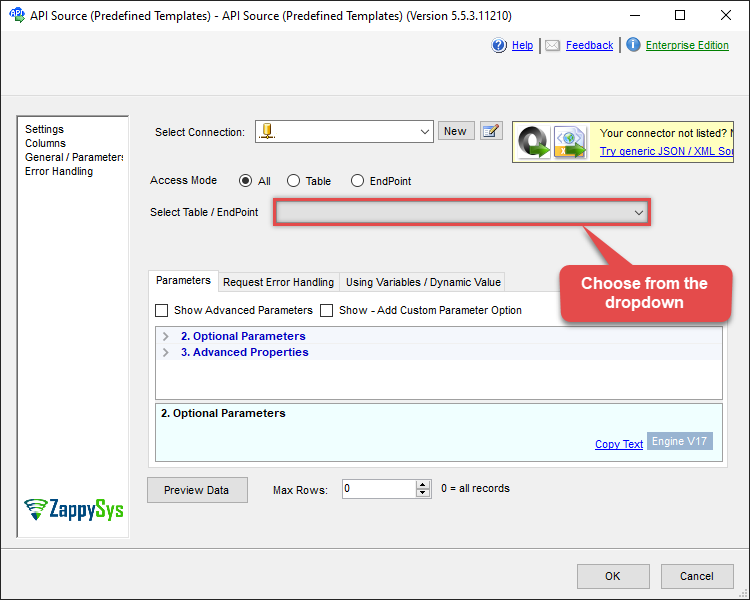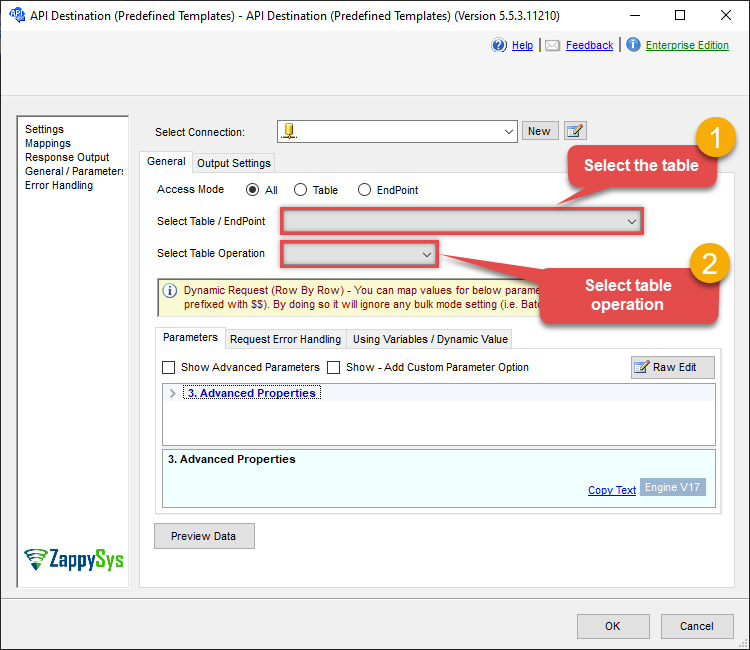Endpoint Get My Messages [only works with User Credentials]
Name
get_my_messages
Description
Get the mail messages for the current user. [API reference]
Related Tables
Parameters
| Parameter | Required | Options | ||||||||||||||||||||||||||||||||||||||||||||||||||||
|---|---|---|---|---|---|---|---|---|---|---|---|---|---|---|---|---|---|---|---|---|---|---|---|---|---|---|---|---|---|---|---|---|---|---|---|---|---|---|---|---|---|---|---|---|---|---|---|---|---|---|---|---|---|---|
|
Name:
Label: Email Body Format |
YES |
|
||||||||||||||||||||||||||||||||||||||||||||||||||||
|
Name:
Label: Search Criteria Data filter (e.g. somecolumn -eq 'somevalue'), you can use Date time functions for dynamic date. You can use keywords like now,today,yesterday,monthstart,monthend,yearstart,yearend,weekstart,weekend along with operator + / - [hour,minute,second,day,month,year] |
|
|||||||||||||||||||||||||||||||||||||||||||||||||||||
|
Name:
Label: MailFolderId |
||||||||||||||||||||||||||||||||||||||||||||||||||||||
|
Name:
Label: Order By Order the specified column by ascending or descending order |
|
|||||||||||||||||||||||||||||||||||||||||||||||||||||
|
Name:
Label: Page Size The number of records to include in each page of results |
||||||||||||||||||||||||||||||||||||||||||||||||||||||
|
Name:
Label: Selected Columns Select the individual columns to be included in the response, to reduce the response size and increase performance |
Output Columns
| Label | Data Type (SSIS) | Data Type (SQL) | Length | Description |
|---|---|---|---|---|
| Id |
DT_WSTR
|
nvarchar(1000)
|
1000 | |
| ReceivedDateTime |
DT_DBTIMESTAMP
|
datetime
|
||
| HasAttachments |
DT_BOOL
|
bit
|
||
| Subject |
DT_WSTR
|
nvarchar(800)
|
800 | |
| BodyPreview |
DT_WSTR
|
nvarchar(4000)
|
4000 | |
| SenderEmailAddressName |
DT_WSTR
|
nvarchar(800)
|
800 | |
| SenderEmailAddress |
DT_WSTR
|
nvarchar(800)
|
800 | |
| Importance |
DT_WSTR
|
nvarchar(500)
|
500 | |
| SentDateTime |
DT_DBTIMESTAMP
|
datetime
|
||
| CreatedDateTime |
DT_DBTIMESTAMP
|
datetime
|
||
| LastModifiedDateTime |
DT_DBTIMESTAMP
|
datetime
|
||
| ChangeKey |
DT_WSTR
|
nvarchar(1000)
|
1000 | |
| ToRecipients |
DT_WSTR
|
nvarchar(1190)
|
1190 | |
| CcRecipients |
DT_WSTR
|
nvarchar(1190)
|
1190 | |
| BccRecipients |
DT_WSTR
|
nvarchar(1190)
|
1190 | |
| ToRecipient1 |
DT_WSTR
|
nvarchar(200)
|
200 | |
| ToRecipient2 |
DT_WSTR
|
nvarchar(200)
|
200 | |
| ToRecipient3 |
DT_WSTR
|
nvarchar(200)
|
200 | |
| ToRecipient4 |
DT_WSTR
|
nvarchar(200)
|
200 | |
| ToRecipient5 |
DT_WSTR
|
nvarchar(200)
|
200 | |
| CcRecipient1 |
DT_WSTR
|
nvarchar(200)
|
200 | |
| CcRecipient2 |
DT_WSTR
|
nvarchar(200)
|
200 | |
| CcRecipient3 |
DT_WSTR
|
nvarchar(200)
|
200 | |
| CcRecipient4 |
DT_WSTR
|
nvarchar(200)
|
200 | |
| CcRecipient5 |
DT_WSTR
|
nvarchar(200)
|
200 | |
| BccRecipient1 |
DT_WSTR
|
nvarchar(200)
|
200 | |
| BccRecipient2 |
DT_WSTR
|
nvarchar(200)
|
200 | |
| BccRecipient3 |
DT_WSTR
|
nvarchar(200)
|
200 | |
| BccRecipient4 |
DT_WSTR
|
nvarchar(200)
|
200 | |
| BccRecipient5 |
DT_WSTR
|
nvarchar(200)
|
200 | |
| Categories |
DT_WSTR
|
nvarchar(1000)
|
1000 | |
| ParentFolderId |
DT_WSTR
|
nvarchar(1200)
|
1200 | |
| ConversationId |
DT_WSTR
|
nvarchar(1200)
|
1200 | |
| ConversationIndex |
DT_WSTR
|
nvarchar(1200)
|
1200 | |
| IsDeliveryReceiptRequested |
DT_BOOL
|
bit
|
||
| IsReadReceiptRequested |
DT_BOOL
|
bit
|
||
| IsRead |
DT_BOOL
|
bit
|
||
| IsDraft |
DT_BOOL
|
bit
|
||
| WebLink |
DT_WSTR
|
nvarchar(4000)
|
4000 | |
| InferenceClassification |
DT_WSTR
|
nvarchar(800)
|
800 | |
| InternetMessageHeaders |
DT_NTEXT
|
nvarchar(MAX)
|
||
| BodyContentType |
DT_WSTR
|
nvarchar(500)
|
500 | |
| BodyContent |
DT_NTEXT
|
nvarchar(MAX)
|
||
| FromEmailAddressName |
DT_WSTR
|
nvarchar(800)
|
800 | |
| FromEmailAddress |
DT_WSTR
|
nvarchar(800)
|
800 | |
| ReplyTo |
DT_WSTR
|
nvarchar(1190)
|
1190 | |
| UniqueBodyContentType |
DT_WSTR
|
nvarchar(500)
|
500 | |
| UniqueBodyContent |
DT_NTEXT
|
nvarchar(MAX)
|
||
| FlagFlagStatus |
DT_WSTR
|
nvarchar(800)
|
800 | |
| ODataETag |
DT_WSTR
|
nvarchar(1000)
|
1000 | |
| InternetMessageId |
DT_WSTR
|
nvarchar(1800)
|
1800 |
Input Columns
| Label | Data Type (SSIS) | Data Type (SQL) | Length | Description | |||||||||||||||||||||||||||||||||||||||||||||||||||||||||||||||||||||||||||||||||||||||||||||||
|---|---|---|---|---|---|---|---|---|---|---|---|---|---|---|---|---|---|---|---|---|---|---|---|---|---|---|---|---|---|---|---|---|---|---|---|---|---|---|---|---|---|---|---|---|---|---|---|---|---|---|---|---|---|---|---|---|---|---|---|---|---|---|---|---|---|---|---|---|---|---|---|---|---|---|---|---|---|---|---|---|---|---|---|---|---|---|---|---|---|---|---|---|---|---|---|---|---|---|---|
| There are no Static columns defined for this endpoint. This endpoint detects columns dynamically at runtime. | |||||||||||||||||||||||||||||||||||||||||||||||||||||||||||||||||||||||||||||||||||||||||||||||||||
Examples
SSIS
Use Outlook Mail (Office 365) Connector in API Source or in API Destination SSIS Data Flow components to read or write data.
API Source
This Endpoint belongs to the MyMessages table, therefore it is better to use it, instead of accessing the endpoint directly:
| There are no parameters to configure. |

API Destination
This Endpoint belongs to the MyMessages table, therefore it is better to use it, instead of accessing the endpoint directly. Use this table and table-operation pair to get my messages [only works with user credentials]:
| There are no parameters to configure. |

ODBC application
Use these SQL queries in your ODBC application data source:
Get messages for the current user
SELECT * FROM MyMessagesGet messages for the current user ordered by the time they were sent in ascending order
SELECT * FROM MyMessages WITH (OrderBy='sentDateTime')Get messages for the current user ordered by the time they were sent in descending order
SELECT * FROM MyMessages WITH (OrderBy='sentDateTime desc')Get messages for the current user ordered by the time they were received in ascending order
SELECT * FROM MyMessages WITH (OrderBy='receivedDateTime')Get messages for the current user ordered by the time they were received in descending order
SELECT * FROM MyMessages WITH (OrderBy='receivedDateTime desc')Get messages for the current user ordered by the name of the sender in ascending order
SELECT * FROM MyMessages WITH (OrderBy='sender/emailAddress/name')Get messages for the current user ordered by the name of the sender in descending order
SELECT * FROM MyMessages WITH (OrderBy='sender/emailAddress/name desc')
get_my_messages endpoint belongs to
MyMessages
table(s), and can therefore be used via those table(s).
SQL Server
Use these SQL queries in SQL Server after you create a data source in Data Gateway:
Get messages for the current user
DECLARE @MyQuery NVARCHAR(MAX) = 'SELECT * FROM MyMessages';
EXEC (@MyQuery) AT [LS_TO_OUTLOOK_MAIL_OFFICE_365_IN_GATEWAY];Get messages for the current user ordered by the time they were sent in ascending order
DECLARE @MyQuery NVARCHAR(MAX) = 'SELECT * FROM MyMessages WITH (OrderBy=''sentDateTime'')';
EXEC (@MyQuery) AT [LS_TO_OUTLOOK_MAIL_OFFICE_365_IN_GATEWAY];Get messages for the current user ordered by the time they were sent in descending order
DECLARE @MyQuery NVARCHAR(MAX) = 'SELECT * FROM MyMessages WITH (OrderBy=''sentDateTime desc'')';
EXEC (@MyQuery) AT [LS_TO_OUTLOOK_MAIL_OFFICE_365_IN_GATEWAY];Get messages for the current user ordered by the time they were received in ascending order
DECLARE @MyQuery NVARCHAR(MAX) = 'SELECT * FROM MyMessages WITH (OrderBy=''receivedDateTime'')';
EXEC (@MyQuery) AT [LS_TO_OUTLOOK_MAIL_OFFICE_365_IN_GATEWAY];Get messages for the current user ordered by the time they were received in descending order
DECLARE @MyQuery NVARCHAR(MAX) = 'SELECT * FROM MyMessages WITH (OrderBy=''receivedDateTime desc'')';
EXEC (@MyQuery) AT [LS_TO_OUTLOOK_MAIL_OFFICE_365_IN_GATEWAY];Get messages for the current user ordered by the name of the sender in ascending order
DECLARE @MyQuery NVARCHAR(MAX) = 'SELECT * FROM MyMessages WITH (OrderBy=''sender/emailAddress/name'')';
EXEC (@MyQuery) AT [LS_TO_OUTLOOK_MAIL_OFFICE_365_IN_GATEWAY];Get messages for the current user ordered by the name of the sender in descending order
DECLARE @MyQuery NVARCHAR(MAX) = 'SELECT * FROM MyMessages WITH (OrderBy=''sender/emailAddress/name desc'')';
EXEC (@MyQuery) AT [LS_TO_OUTLOOK_MAIL_OFFICE_365_IN_GATEWAY];
get_my_messages endpoint belongs to
MyMessages
table(s), and can therefore be used via those table(s).
